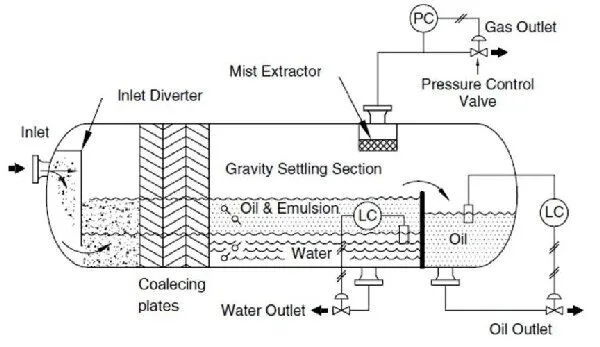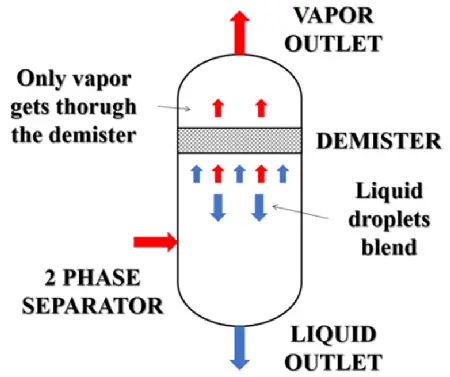Two Phase vs. Three Phase Separators: Key in Fluid Separation
On this page
In the oil and gas industry as well as in chemical production, separators are key equipment to ensure the efficiency of fluid processing and the stability of processes. The main task of separators is to effectively separate different phases (gas, liquid, solid) in mixed fluids, thereby achieving fine processing and handling of raw materials. According to the different phases separated, separators can be divided into two-phase separators and three-phase separators. Two-phase separators are used for gas-liquid separation, while three-phase separators further divide the liquid phase into oil and water phases. This article will delve into the structure, working principle, and specific industrial applications of three-phase and two-phase separators.
Three-Phase Separators
In the oil and gas industry, three-phase separators are important equipment for processing mixed fluids, and their design purpose is to effectively separate gas, oil, and water into three phases. With a reasonable internal structure and process design, three-phase separators can ensure precise separation and stable operation of fluids under various complex process conditions.

1. Structure and Composition
A three-phase separator typically includes three main areas: the primary separation area, the gravity separation area, and the demisting area. These areas work together to achieve effective separation of gas, oil, and water.
Primary Separation Area: Fluids enter this area through the inlet, where the inlet deflector suddenly changes the direction and speed of the fluid. Most droplets hit the deflector here and fall down due to gravity, achieving preliminary separation of the liquid phase from the gas phase.
Gravity Separation Area: This is the key part of the three-phase separator. The flow rate of the gas and liquid phase in this area is slower, and small droplets gradually separate from the gas phase under the action of gravity and buoyancy. In this area, the liquid is separated into oil and water phases by gravity, with the oil phase floating up due to its lower density, while the water phase sinks.
Demisting Area: Since very small droplets are difficult to completely separate in the gravity separation area, the demisting area is specifically used to further remove these residual droplets. Usually, there are impact planes in the demisting area, where small droplets gather to form larger droplets and eventually separate from the gas flow under the action of gravity.
2. Working Principle
The gas-liquid mixed fluid enters the three-phase separator through the gas-liquid inlet and first achieves preliminary separation of gas and liquid in the primary separation area. The gas enters the gas channel, and droplets are separated and settle into the liquid area through rectification and gravity settling. The liquid then enters the liquid space, separates bubbles, and achieves oil-water separation under the action of gravity. Finally, the gas is discharged from the outlet after the residual droplets are removed by the demister, the oil flows into the oil tank from the overflow baffle at the top and is discharged from the oil outlet, and the water is discharged from the drainage outlet.
3. Applications and Advantages
Three-phase separators are widely used in oil and gas production, especially in processes that require the mixture to be separated into gas, oil, and water phases. Their main advantage lies in the effective separation of fluids with different densities and the provision of stable operational performance to ensure the normal progress of downstream processing processes.
Two-Phase Separators
Two-phase separators are one of the common equipment in industrial production, mainly used to separate gas-liquid mixtures into gas and liquid phases. With a simple and efficient design, they can meet a variety of process requirements and ensure effective separation of fluids under various conditions.

1. Structure and Composition
The structure of a two-phase separator is relatively simple, usually including an inlet distributor, a gravity settling area, and a demisting area. Despite the simple structure, its design can still effectively complete the task of gas-liquid separation.
Inlet Distributor: After the fluid enters the separator, it first passes through the inlet distributor, which changes the direction of fluid flow and reduces its speed, allowing most droplets to settle.
Gravity Settling Area: The gas-liquid mixture is separated in this area, with droplets settling into the liquid space due to gravity, while the gas continues to flow upward.
Demisting Area: This area is used to remove residual tiny droplets in the gas, usually achieved by installing a demister. This process ensures that the gas reaches the expected purity before leaving the separator.
2. Working Principle
In the two-phase separator, the gas-liquid mixed fluid enters the equipment through the inlet, with the gas entering the gravity settling area, where droplets settle into the liquid space due to gravity. After preliminary separation, the gas continues to rise, enters the demisting area, and is discharged from the outlet after the residual droplets are removed by the demister. The liquid further separates bubbles and solid impurities in the liquid space and is finally discharged from the liquid outlet.
3. Applications and Advantages
Two-phase separators are widely used in situations that require simple gas-liquid separation, such as natural gas dehydration or oil field gas-liquid separation. Their design is simple but powerful, capable of adapting to various process conditions and fluid characteristics. Due to their simple structure, two-phase separators have lower maintenance costs and are more convenient to operate.
Comparison of Three-Phase and Two-Phase Separators
The main difference between three-phase and two-phase separators lies in their separation functions. Two-phase separators focus on dividing the mixed fluid into gas and liquid phases, suitable for scenarios that do not require complex liquid phase separation. Three-phase separators, on the other hand, can further separate the mixed fluid into gas, oil, and water phases, thus being more widely used in oil and gas production and processing processes.
1. Separation Function
Two-phase separators are mainly used for gas-liquid separation, while three-phase separators can not only separate gas and liquid but also further separate oil and water.
2. Internal Structure
The structure of a two-phase separator is relatively simple, only requiring a liquid level controller and a liquid level control valve, while a three-phase separator requires additional internal components and control devices, such as overflow baffles and multi-level liquid level controllers, to achieve three-phase separation.
3. Application Scenarios
Two-phase separators are usually used for simple gas-liquid separation processes, while three-phase separators are widely used in complex processes such as oil and gas processing and petrochemical processing.
Three-phase and two-phase separators play an important role in industrial production, and their respective structural and functional designs enable them to meet different separation needs. Choosing the appropriate type of separator according to the specific requirements of the production process can greatly improve production efficiency and ensure the stability and safety of the process. In future industrial applications, with the advancement of technology, the design and performance of these separators will continue to be optimized to meet increasingly complex process requirements.

